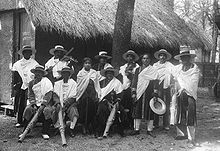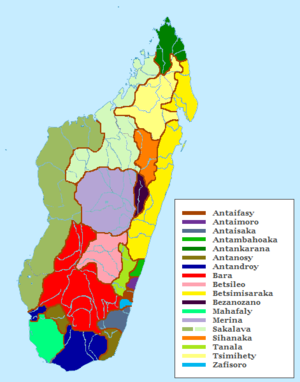Malagasy people
This article needs additional citations for verification. (September 2014) |
  Top: A Malagasy street vendor; Bottom: A traditional Malagasy Valiha orchestra | |
| Total population | |
|---|---|
| c. 26.8 million | |
| Regions with significant populations | |
| Madagascar, Comoros, Mayotte, Réunion, Mauritius, France, United Kingdom, United States, South Africa, Australia, Canada, New Zealand | |
| Languages | |
| Malagasy, French | |
| Religion | |
| Malagasy mythology, Protestantism, Catholicism, Islam | |
| Related ethnic groups | |
| Austronesian peoples (esp. Ma'anyan, Banjar, Dusun, Paku , Lawangan, Other Barito peoples) and Bantu peoples |

The Malagasy (French: Malgache) are an ethnic group native to the island country of Madagascar. Their ancestry is the combination of continental African Bantu-speaking peoples who migrated from the Eastern coast of mainland Africa, and the Southeast Asian migrants of Austronesian stock, who migrated from Borneo and other islands of Indonesia of Maritime Southeast Asia.[1]
Traditionally the population have been divided by subgroups (tribes or ethnicities), but the relevance of this subdivision is disputed. Examples include "Highlander" groups: Merina, Sihanaka and Betsileo of the central highlands around Antananarivo, Alaotra (Ambatondrazaka) and Fianarantsoa, and the "coastal dwellers" with tribes like the Sakalava, Bara, Vezo, Betsimisaraka, Mahafaly, etc.
Genetics and origins of the populations[]
The Malagasy were enumerated at 2,242,000 in the first census in 1900. Its population experienced a massive growth in the next hundred years, especially under French Madagascar.


The genetics element about the dual origin of the Malagasy can be traced to the mid-20th century with results regarding blood group distribution. An expansive island-wide survey of the genetic diversity has been performed from 2008 to 2018. This project was called "MAGE" (for Madagascar, Anthropology Genetics Ethno-linguistic[2]). Around 3000 inhabitants of Madagascar have participated in this study and provided their saliva for a genetic study. 300 villages across Madagascar have been sampled in terms of genetic, linguistic and cultural diversity. This research was led and performed by Malagasy and European researchers and academics. This study demonstrated that all Malagasy people have mixed African and Asian ancestry.[3]
But the proportion of ancestral genes differs. Coastal Malagasy populations, including the Temoro, Vezo, and Mikea, etc. have approx. 70% African ancestry and 30% Asian ancestry.[4] while highlander tribes tend to have lower African ancestry at around 45%[3].In a recent island-wide survey the male-only Y chromosomes of African origin are more common than those of East Asian origin, but it varies depending on the study (70.7 vs. 20.7 or 51% vs 34%).[5] However the mtDNA lineages, passed down from mother to child, are the opposite (42.4% African origin vs. 50.1% East Asian origin).[6]
Due to the proximity to Africa, the connection with Asian populations exhibited the most curiosity. Around 1996, a study to identify the presence of the Polynesian motif in the Malagasy population (mtDNA haplotype B4a1a1a). A more recent study to identify two additional mutations (1473 and 3423A) found in all Polynesian motif carriers of Madagascar, hence named the Malagasy motif.[7] The frequency varied among three ethnic groups: 50% in Merina, 22% in Vezo, and 13% in Mikea. Based on this result, a study suggested that Madagascar was settled approximately 1,200 years ago by a very small group, which consisted of approximately 30 women, where 28 (93%) of them have maritime Southeast Asian descent and 2 (7%) of them have African descent.[7] But this result is not consistent with more extensive data accumulated.[3] The Malagasy population existed through the intermixing of the first founding population. The closest Asian parental population of the Malagasy are the Banjar and other South Kalimantan Dayak people of south east Borneo.[8][9] Language footprints of their ancestors from Southeastern Asia can presently be witnessed by many shared basic vocabulary with Ma'anyan, a language from the region of the Barito River in southern Borneo.
Historical subdivisions[]
The difference in origins remains somewhat evident between the highland and coastal regions[citation needed]. In addition to the distinction in term of ancestral proportion between highland and coastal Malagasy, one may speak of a political distinction as well. Merina monarchs in the late 18th and early 19th century, united the Merina principalities and brought the neighbouring Betsileo people under their administration first. They later extended Merina control over the majority of the coastal areas. The neighbouring island of Moheli was also ruled by a Muslim Merina dynasty founded by Abderremane, Sultan of Mohéli, who was a brother-in-law of King Radama I. The military resistance and eventual defeat of most of the coastal communities assured their subordinate position vis-à-vis the Merina-Betsileo alliance. During the 19th and 20th centuries, the French colonial administration capitalized on and further exacerbated these political inequities by appropriating existing Merina governmental infrastructure to run their colony. This legacy of political inequity dogged the people of Madagascar after gaining independence in 1960; candidates' ethnic and regional identities have often served to help or hinder their success in democratic elections.
Within these two broad ethnic and political groupings, the Malagasy were historically subdivided into specifically named ethnic groups, who were primarily distinguished from one another on the basis of cultural practices. These were namely agricultural, hunting, or fishing practices; construction style of dwellings; music; hair and clothing styles; and local customs or taboos, the latter was known in the Malagasy language as fady.[citation needed] The number of such ethnic groups in Madagascar has been debated. The practices that distinguished many of these groups are less prevalent in the 21st century than they were in the past. But, many Malagasy are proud to proclaim their association with one or several of these groups as part of their own cultural identity.
- "Highlander" ethnic groups
- Coastal ethnic groups
- Antaifasy or Antefasy
- Antaimoro or Temoro or Antemoro
- Antaisaka or Antesaka
- Antambahoaka
- Antandroy or Tandroy
- Antankarana
- Antanosy or Tanosy
- Bara
- Betsimisaraka
- Bezanozano
- Mahafaly
- Makoa
- Mikea
- Sakalava
- Tanala
- Tsimihety
- Vezo
Malagasy diaspora[]
Countries with a significant Malagasy diaspora include France (specifically the overseas departments of Mayotte and Réunion),[10] Comoros (specifically the island of Moheli), South Africa, Latin America and the Caribbean and the United States.
The Malagasy diaspora in the United States includes those descended from people who, slave or free, came during the 18th and 19th centuries.[11] Other Americans of Malagasy descent are recent immigrants from Madagascar. Some notable Americans of Malagasy descent include Andy Razaf, Katherine Dunham, Regina M. Anderson, William H. Hastie, George Schuyler and Philippa Schuyler, Muhammad Ali,[12] Robert Reed Church and Mary Church Terrell, Frederick D. Gregory,[13] Thomas P. Mahammitt,[14] Paschal Beverly Randolph, Maya Rudolph,[15] Claude McKay, Jess Tom, Ben Jealous,[16] and Keenan Ivory Wayans.[17]
Malagasy were also brought to Latin America, notably Peru, during the Transatlantic Slave Trade. A community of descendants of these Malagasy reside in Morropón (Piura), a city in northern Peru; the Afro-Peruvians of Malagasy descent number about 7,000.[18] Luis Miguel Sánchez Cerro, the Peruvian army officer who served as the 48th President of Peru from 1931 to 1933, as well as Interim President of Peru, was a notable descendant of this community. They call themselves Mangaches or Malgaches. This section of Piura is called la Mangachería.
The first recorded African slave in Canada, Olivier Le Jeune, was taken from Madagascar to New France in 1628.
See also[]
- Malagasy language
- Culture of Madagascar
- Seychellois Creole people
- Mauritian Creoles
- Cafres
- Cape Malay
References[]
- ^ Heiske, Margit; Alva, Omar; Pereda-Loth, Veronica; Van Schalkwyk, Matthew; Radimilahy, Chantal; Letellier, Thierry; Rakotarisoa, Jean-Aimé; Pierron, Denis (2021-01-22). "Genetic evidence and historical theories of the Asian and African origins of the present Malagasy population". Human Molecular Genetics. 30 (R1): R72–R78. doi:10.1093/hmg/ddab018. ISSN 0964-6906. PMID 33481023.
- ^ "Madagascar, illustration inédite de la mondialisation génétique | INEE". inee.cnrs.fr (in French). Retrieved 2021-02-25.
- ^ Jump up to: a b c Pierron, Denis; Heiske, Margit; Razafindrazaka, Harilanto; Rakoto, Ignace; Rabetokotany, Nelly; Ravololomanga, Bodo; Rakotozafy, Lucien M.-A.; Rakotomalala, Mireille Mialy; Razafiarivony, Michel; Rasoarifetra, Bako; Raharijesy, Miakabola Andriamampianina (2017-08-08). "Genomic landscape of human diversity across Madagascar". Proceedings of the National Academy of Sciences. 114 (32): E6498–E6506. doi:10.1073/pnas.1704906114. ISSN 0027-8424. PMC 5559028. PMID 28716916.
- ^ Pierron, Denis; Razafindrazaka, Harilanto; Pagani, Luca; Ricaut, François-Xavier; Antao, Tiago; Capredon, Mélanie; Sambo, Clément; Radimilahy, Chantal; Rakotoarisoa, Jean-Aimé; Blench, Roger M.; Letellier, Thierry (2014-01-21). "Genome-wide evidence of Austronesian–Bantu admixture and cultural reversion in a hunter-gatherer group of Madagascar". Proceedings of the National Academy of Sciences. 111 (3): 936–941. Bibcode:2014PNAS..111..936P. doi:10.1073/pnas.1321860111. ISSN 0027-8424. PMC 3903192. PMID 24395773.
- ^ Tofanelli, S.; Bertoncini, S.; Castri, L.; Luiselli, D.; Calafell, F.; Donati, G.; Paoli, G. (2009). "On the Origins and Admixture of Malagasy: New Evidence from High-Resolution Analyses of Paternal and Maternal Lineages" (PDF). Molecular Biology and Evolution. 26 (9): 2109–2124. doi:10.1093/molbev/msp120. PMID 19535740. S2CID 22042499. Archived from the original (PDF) on 2018-01-21.
- ^ Pierron, Denis; Heiske, Margit; Razafindrazaka, Harilanto; Rakoto, Ignace; Rabetokotany, Nelly; Ravololomanga, Bodo; Rakotozafy, Lucien M.-A.; Rakotomalala, Mireille Mialy; Razafiarivony, Michel; Rasoarifetra, Bako; Raharijesy, Miakabola Andriamampianina; Razafindralambo, Lolona; Ramilisonina; Fanony, Fulgence; Lejamble, Sendra; Thomas, Olivier; Mohamed Abdallah, Ahmed; Rocher, Christophe; Arachiche, Amal; Tonaso, Laure; Pereda-loth, Veronica; Schiavinato, Stéphanie; Brucato, Nicolas; Ricaut, Francois-Xavier; Kusuma, Pradiptajati; Sudoyo, Herawati; Ni, Shengyu; Boland, Anne; Deleuze, Jean-Francois; Beaujard, Philippe; Grange, Philippe; Adelaar, Sander; Stoneking, Mark; Rakotoarisoa, Jean-Aimé; Radimilahy, Chantal; Letellier, Thierry (2017). "Genomic landscape of human diversity across Madagascar". Proceedings of the National Academy of Sciences. 114 (32): E6498–E6506. doi:10.1073/pnas.1704906114. PMC 5559028. PMID 28716916.
- ^ Jump up to: a b Cox, Murray P.; Nelson, Michael G.; Tumonggor, Meryanne K.; Ricaut, François-X.; Sudoyo, Herawati (2012). "A small cohort of Island Southeast Asian women founded Madagascar". Proceedings of the Royal Society B: Biological Sciences. 279 (1739): 2761–2768. doi:10.1098/rspb.2012.0012. PMC 3367776. PMID 22438500.
- ^ Kusuma, Pradiptajati; Brucato, Nicolas; Cox, Murray P.; Pierron, Denis; Razafindrazaka, Harilanto; Adelaar, Alexander; Sudoyo, Herawati; Letellier, Thierry; Ricaut, François-Xavier (2016). "Contrasting Linguistic and Genetic Origins of the Asian Source Populations of Malagasy". Scientific Reports. 6 (1): 26066. Bibcode:2016NatSR...626066K. doi:10.1038/srep26066. PMC 4870696. PMID 27188237.
- ^ Brucato, Nicolas; Kusuma, Pradiptajati; Cox, Murray P.; Pierron, Denis; Purnomo, Gludhug A.; Adelaar, Alexander; Kivisild, Toomas; Letellier, Thierry; Sudoyo, Herawati; Ricaut, François-Xavier (2016). "Malagasy Genetic Ancestry Comes from an Historical Malay Trading Post in Southeast Borneo". Molecular Biology and Evolution. 33 (9): 2396–2400. doi:10.1093/molbev/msw117. ISSN 0737-4038. PMC 4989113. PMID 27381999.
- ^ Malagasy expatriates in France
- ^ Wendy Wilson-Fall on Malagasy Americans, Afropop.org, Accessed January 18, 2020
- ^ John, Egerton (September 1, 1991). Shades of Gray: Dispatches from the Modern South. p. 134.
- ^ NASA Johnson Space Center Oral History Project, April 29, 2004. Accessed May 15, 2020.
- ^ An American Family: The Mahammett Family of Maryland, Muslimsinamerica.org, Accessed January 18, 2020
- ^ “Finding Your Roots”: Maya Rudolph, Shonda Rhimes and Keenan Ivory Wayans, Familytreemagazine.com, Accessed May 15, 2020
- ^ Henry Louis Gates Jr., Finding Your Roots, Season 2: The Official Companion to the PBS Series, University of North Carolina Press, 2016, pg. 163
- ^ “Finding Your Roots”: Maya Rudolph, Shonda Rhimes and Keenan Ivory Wayans, Familytreemagazine.com, Accessed February 10, 2020
- ^ Maidei Magirosa (June 26, 2014). "Strong African presence in Peru". thePatriot. Retrieved April 15, 2015.
Further reading[]
- Memories of Madagascar and Slavery in the Black Atlantic by Wendy Wilson-Fall, 2015, Ohio University Press—Malagasy diaspora
- Sandra Evers, Gwyn Campbell, Michael Lambek (2013). Contest for Land in Madagascar: Environment, Ancestors and Development. African Social Studies Series. Brill. ISBN 9004256237, ISBN 9789004256231.
- Malagasy people
- Ethnic groups in Madagascar
- Austronesian peoples
- Bantu peoples
- Asian diaspora in Africa